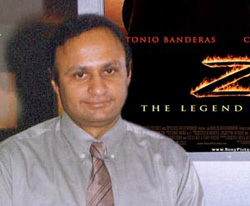Arts
Hollywood Lives For Another Day

Hollywood's plodding passage to India.
|
Despite being the world’s most powerful film industry, Hollywood has barely made a dent in the Indian film market.
“Hovering between $40-45 million, the box office collections from the international sector is still small compared to that from the Indian films, anywhere between 3 to 5 percent,” says Uday Singh, chief executive officer of Sony Pictures Releasing International India (SPRI). “This makes India along with the USA the biggest market for ‘local language’ films.” In fact, this year, when ticket sales are down 5 to 15 percent year over year across all key Asian markets, Hollywood has slipped in India too. “The box office share of Hollywood films vis-a-vis local content has declined marginally from about 8 percent in 2002-03 to 5 percent in 2004-05,” says Ajjay Bijli, chairman & managing director, PVR Ltd., film distributors and owner of India’s largest chain of multiplexes. So why has the year been so bad for Hollywood in India? It is the local content, the power of a resurgent Bollywood that is giving Hollywood a run for its money. “This has been a particularly good year for Bollywood with at least one film hitting the box office bull’s eye every month,” says veteran film critic and industry-watcher Saibal Chatterjee. “Especially striking has been the fact that many of the Mumbai films that have clicked commercially are those that could be described as unconventional – Black, Page 3, Bunty Aur Babli, Sarkar, Iqbal, etc. As a result, the multiplexes have been kept busy. Add to that usual run-of-the-mill films like Maine Pyaar Kyun Kiya and No Entry and you have Bollywood’s most successful year in an entire decade.” “In contrast, Hollywood has had a terrible domestic summer this year, as a result of which very few big-ticket films from the US have hit the Indian market,” says Chatterjee. “Hollywood has been trying very hard over the years to expand its Indian market share.”
Strange as it may seem, although Hollywood has captured over 90 per cent of the European market (and a large share in other markets too), the Indian film industry is standing up to the might of a resourceful Hollywood! And, interestingly, it isn’t a small market either. India represents 73 percent of the Asia Pacific theatre admissions, at $2.9 billion a year. Estimates project that by 2025, the largest audiences in the world will be in China and India. With increasing literacy levels, the demand for international fare among the English-educated Indians is growing. Post-globalization, the well-heeled urban Indians, especially growing mid- and high-income segments, are rediscovering the magic of cinema in the plush multiplexes. And for them, Tom Cruise, Steven Spielberg and Julia Roberts are as good as Shahrukh Khan, Karan Johar, and Rani Mukherjee. These developments suit Hollywood very well. Fighting saturation at its home turf, it has turned to markets like India and China to increase its bottom-line. When Hollywood entered the Indian film market in 1992, it grossed a paltry $1.3 million. Since then, the profits and the audience have multiplied phenomenally. “Hollywood films have seen a growth of 33 percent in the last 4 years,” says Uday Singh. Despite being a marginal player, Hollywood companies have made dazzling moves to grow their business in India. In a messy marketplace where no one knows the actual box office collections, Columbia Tristar even set up a system across the country that helps it collect data on ticket sales on a 24×7 basis, making its operations transparent. While the growth of multiplexes has allowed the Hollywood distributors to releases more titles with increased prints per movie (Spiderman-2 opened with over 300 prints), increased acceptability of dubbed films has widened the mass appeal of Hollywood films. From 1997, when India got its first multiplex – the PVR Anupam in Delhi – to 2005, there has been sort of a multiplex revolution in the country. India now boasts 73 multiplexes, with 276 screens and about 89,470 seats. Until the multiplexes arrived in India, most filmgoers had to watch movies in single-screen theaters with 1,000 to 1,500 seats, most of them in an advanced state of decay. After the first multiplex opened, a few state governments began supporting them with entertainment tax exemptions. This prompted a multiplex boom in the major cities. The numbers are expected to increase to 135 multiplexes with more than 160,000 seats by the end of 2006.
Despite their small but growing numbers, the multiplexes have a disproportionately huge impact on the box office collections. According to a report by YES Bank and the Film and Television Producers Guild of India (May 2005), though multiplexes constitute only 0.6 percent of about 12,000 cinema halls in the country, they accounted for 28-34 percent of the box office take for the Top 50 films in 2004. Earlier, because of single screens, theater-owners preferred to exhibit, by and large, only Indian films. Because of the multiplexes, Hollywood studios could release a good number of their films in the country. “In a year, approximately 70-72 films are released by the Hollywood Studios in India while releases from other sources (the Independent Importers) are not known,” says Singh. Buoyed by the initial success, soon Hollywood realized the market potential of its films in Hindi and other regional languages, which so far had been untapped. Thus began the trend of dubbing Hollywood films in several languages and releasing them all across India. Films like Jurassic Park, Godzilla, Titanic, Spiderman and Anaconda, with their dubbed versions, have done tremendous business. For example, Spiderman raked in revenues of $6.6 million while its sequel Spiderman 2 grossed $7.44 million. Godzilla also grossed over $6 million. Also, forced by cable television and rampant piracy, Hollywood studios began bringing major releases to India just a few weeks after their worldwide launch. Matrix Revolutions was the first Hollywood movie that was released in India on November 5, 2003, at the same time as the rest of the world. “The gap between the US and India release dates of many movies has shrunk, and there has also been tremendous growth through dubbing the movies in regional languages,” says Ajjay Bijli. All these success stories are also partly due to that fact that Hollywood films are now being given full-spectrum marketing treatment in India. “What has also helped Hollywood penetrate the Indian market is the almost 100 percent increase in the marketing and publicity budgets for all Hollywood films by the major studios,” says Bijli. “Hollywood is promoting its big-ticket films like any other big Bollywood release,” says trade analyst Komal Nahata. “Premieres are being held here. There are tie-ups with corporates and there is even merchandising at a small level,” he adds. Promotions of Hollywood films are being adapted to suit the local taste and flavor. “They even painted the action figure on Mumbai trains to promote Spiderman 2,” says Nahata.
How well are the Hollywood companies applying their cutting-edge marketing savvy in India? “Better and more focused marketing campaigns aimed at the core target audience, rather than trying to please everyone is the rule of the game,” says Singh. “Each campaign is a 360 degree effort to reach the core group and this becomes the ‘alpha’ consumers who generate the buzz for the film. The entire process starts at the retail level – through a definite tailoring and merchandising strategy which is worked out for every product and simultaneously the national marketing team pitches with various brands for promotional tie-ups, with media houses for on air or in print campaigns. There is also an attempt to understand the target consumer better and this is done through research.” The effective use of media, both new and old, is also helping Hollywood attract audiences. “Media penetration and internet usage has created greater awareness for Hollywood films in India, right from the time they are ‘greenlit’ in the U.S., which increases once the film opens there,” says Singh. “U.S. Reviews and Box office figures are flashed across Indian media and the buzz continues with the Indian media giving space to these films till their release in India.” For example, Hollywood’s marketing success stories in the recent past have been Spiderman2, xXx, Pirates of the Caribbean, Terminator 3, Hitch, and The Incredibles. One of the most innovative projects was The Incredibles, for which SPRI even got Bollywood superstar Shahrukh Khan and his real-life son to dub for the Hindi version of the film. Similarly, to promote Spiderman 2, Sony especially created a song by the Pakistani band “Strings.” The film’s publicity was tied-in with some of the most successful television programs in India. Sony Ericsson even launched their first branded phones in the country with Spidey’s image on the handset. Looking at the market potential, Hollywood companies are getting active in India. PVR Pictures, film distribution arm of the Priya Village Roadshow group, has struck deals with Kathy Morgan International and Initial Entertainment Group (IEG) to distribute their films in India. Priya already has an association with Miramax. Hollywood-based producer has announced that he would theatrically distribute at least 30 classic films from MGM’s library in India through his . Miramax’s international sales and ution head Michael Rothstein told The Hindustan Times recently that the company would market Hollywood productions in India and was considering producing and marketing local titles. Miramax has already co-produced and marketed Gurinder Chadha’s Bride and Prejudice. Indian movies cost around $7 million and could provide good returns, Rothstein added.
Hollywood studios are also increasingly looking at possibilities of tie-ups with Indian filmmakers. In a well-publicized move, SPRI recently signed up hot-shot Bollywood director Sanjay Leela Bhansali for a teenage love story, Saawaryia. Already green-lit is Tree of Life, starring Colin Farrell, directed by Terence Malick and co-produced by Percept and Sahara One Motion Pictures and Donald Rosenfeld. Percept Picture Company has also joined hands with maverick filmmaker Ram Gopal Varma to co-produce the producer-director’s first ever exclusively American film, Within. In addition, several Indo-U.S. co-productions are already in the pipeline such as Manish Gupta’s Karma, Confessions, and Holi. Saregama Films and Hollywood’s Drena De Niro, Robert De Niro’s adopted daughter, are co-producing a New-York based relationships film, Karma. So, how does the future of Hollywood look like in India? “In view of the very strong local product and the jump in the number of local films being produced due to the multiplexes, we do not expect a substantial penetration of Hollywood films,” says Bijli. “It appears to be unlikely that the share of Hollywood films vis a vis local films will go beyond 8-10% in the next 3 years.” Who knows? An innovative Hollywood can throw a bigger surprise! Agrees Indu Mirani, trade analyst and Associate Editor, Box Office: “Hollywood has a bright future in India. As the multiplexes grow, the audience will also grow.” How fast that growth will be, only time can tell. Case Study 1 Spiderman 2: The Sony Synergy Sony Ericsson launched their first branded phones in India (Spiderman 2 mobile phones). These phones were promoted through a tie-in with the film. Sony Electronics also played a part. Their first major film promotion in India was through their hi-end retail stores “Sony World”. Sony Pictures Home Entertainment promoted the film through their DVD and VCD sales for Spiderman (the first part). Case Study 2 In Hum Hain Lajaawab, real life father and son join forces to play reel life father and son with the King Khan playing Mr. Incredible/Mr. Lajawab and Aryan, Mr. Lajawab’s extraordinarily quick son playing “Dash/ Tez.” This was a casting coup of phenomenal proportions since it is for a dubbed version of a Hollywood film. Partnering the Badshah was the versatile Javed Jaffery who not only lent his voice to the character of ‘Syndrome’ called “Sankiman” in Hum Hain La Jawab but also wrote the dialogues for the movie. The beautiful Rakshanda Khan plays ElastiGirl, also known as Mrs Lajawab. Bollywood superstar Shahrukh Khan and his real-life son dubbed the Hindi version of The Incredibles. Major Hollywood BO Hits in India (in millions) Hollywood’s Major Initiatives in India -Simultaneous release of blockbuster films and India release within 3-4 weeks for other major films, vis a vis the time difference between US and India release, which was as long as 6 months to a year, about 4 years back -Dubbing of the blockbusters to reach untapped market -Increase of almost 100 percent in the marketing and publicity budgets for all Hollywood films by the major studios
|





